Engage NY Eureka Math 1st Grade Module 2 Lesson 27 Answer Key
Eureka Math Grade 1 Module 2 Lesson 27 Sprint Answer Key
A
*Write the missing number.
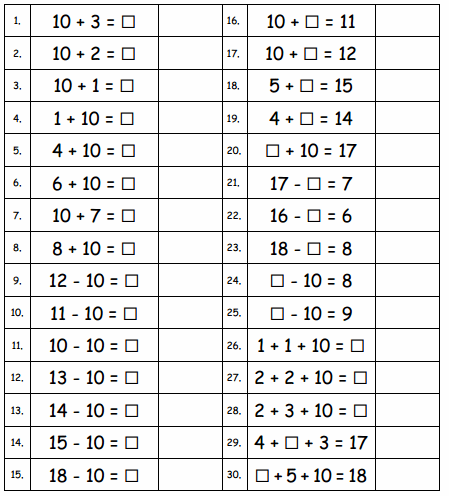
Answer:
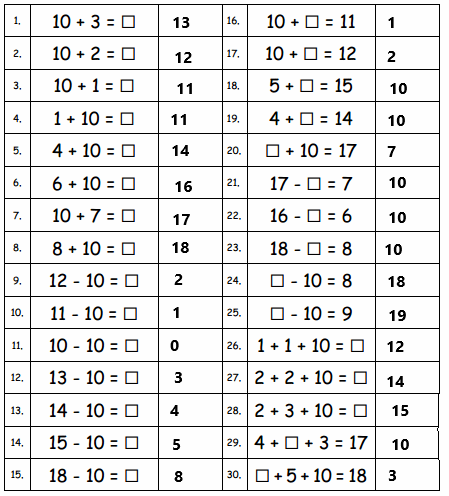
Question 1.
10 + 3 = ☐
Answer:
10 + 3 = 13
Explanation:
An addition sentence is a mathematical expression that shows two or more values added together. ADD ten with three then we got thirteen. The missing number is thirteen.
Question 2.
10 + 2 = ☐
Answer:
10 + 2 = 12
Explanation:
An addition sentence is a mathematical expression that shows two or more values added together. ADD ten with two then we got twelve. The missing number is twelve.
Question 3.
10 + 1 = ☐
Answer:
10+ 1 = 11
Explanation:
An addition sentence is a mathematical expression that shows two or more values added together. ADD ten with one then we got eleven. The missing number is eleven.
Question 4.
1 + 10 = ☐
Answer:
1 + 10 = 11
Explanation:
An addition sentence is a mathematical expression that shows two or more values added together. ADD one with ten then we got eleven. The missing number is eleven.
Question 5.
4 + 10 = ☐
Answer:
4 + 10 = 14
Explanation:
An addition sentence is a mathematical expression that shows two or more values added together. ADD four with ten then we got fourteen. The missing number is fourteen.
Question 6.
6 + 10 = ☐
Answer:
6 + 10 = 16
Explanation:
An addition sentence is a mathematical expression that shows two or more values added together. ADD six with ten then we got sixteen. The missing number is sixteen.
Question 7.
10 + 7 = ☐
Answer:
10 + 7 = 17
Explanation:
An addition sentence is a mathematical expression that shows two or more values added together. ADD ten with seven then we got seventeen. The missing number is seventeen.
Question 8.
8 + 10 = ☐
Answer:
8 + 10 = 18
Explanation:
An addition sentence is a mathematical expression that shows two or more values added together. ADD eight with ten then we got eighteen. The missing number is eighteen.
Question 9.
12 – 10 = ☐
Answer:
12 – 10 = 2
Explanation:
Subtraction is an arithmetic operation that represents the operation of removing objects from a collection. The result of a subtraction is called a difference. Subtract ten from twelve then we got two. The missing number is two.
Question 10.
11 – 10 = ☐
Answer:
11 – 10 = 1
Explanation:
Subtraction is an arithmetic operation that represents the operation of removing objects from a collection. The result of a subtraction is called a difference. Subtract ten from eleven then we got one. The missing number is one.
Question 11.
10 – 10 = ☐
Answer:
10 – 10 = 0
Explanation:
Subtraction is an arithmetic operation that represents the operation of removing objects from a collection. The result of a subtraction is called a difference. Subtract ten from ten then we got zero. The missing number is zero.
Question 12.
13 – 10 = ☐
Answer:
13 – 10 = 3
Explanation:
Subtraction is an arithmetic operation that represents the operation of removing objects from a collection. The result of a subtraction is called a difference. Subtract ten from thirteen then we got three. The missing number is three.
Question 13.
14 – 10 = ☐
Answer:
14 – 10 = 4
Explanation:
Subtraction is an arithmetic operation that represents the operation of removing objects from a collection. The result of a subtraction is called a difference. Subtract ten from fourteen then we got four. The missing number is four.
Question 14.
15 – 10 = ☐
Answer:
15 – 10 = 5
Explanation:
Subtraction is an arithmetic operation that represents the operation of removing objects from a collection. The result of a subtraction is called a difference. Subtract ten from fifteen then we got five. The missing number is five.
Question 15.
18 – 10 = ☐
Answer:
18 – 10 = 8
Explanation:
Subtraction is an arithmetic operation that represents the operation of removing objects from a collection. The result of a subtraction is called a difference. Subtract ten from eighteen then we got eight. The missing number is eight.
Question 16.
10 + ☐ = 11
Answer:
10 + 1 = 11
Explanation:
An addition sentence is a mathematical expression that shows two or more values added together. ADD ten with one then we got eleven. The missing number is one.
Question 17.
10 + ☐ = 12
Answer:
10 + 2 = 12
Explanation:
An addition sentence is a mathematical expression that shows two or more values added together. ADD ten with two then we got twelve. The missing number is two.
Question 18.
5 + ☐ = 15
Answer:
5 + 10 = 15
Explanation:
An addition sentence is a mathematical expression that shows two or more values added together. ADD five with ten then we got fifteen. The missing number is ten.
Question 19.
4 + ☐ = 14
Answer:
4 + 10 = 14
Explanation:
An addition sentence is a mathematical expression that shows two or more values added together. ADD four with two then we got fourteen. The missing number is ten.
Question 20.
☐ + 10 = 17
Answer:
7 + 10 = 17
Explanation:
An addition sentence is a mathematical expression that shows two or more values added together. ADD seven with ten then we got seventeen. The missing number is seven.
Question 21.
17 – ☐ = 7
Answer:
17 – 10 = 7
Explanation:
Subtraction is an arithmetic operation that represents the operation of removing objects from a collection. The result of a subtraction is called a difference. Subtract ten from seventeen then we got seven. The missing number is ten.
Question 22.
16 – ☐ = 6
Answer:
16 – 10 = 6
Explanation:
Subtraction is an arithmetic operation that represents the operation of removing objects from a collection. The result of a subtraction is called a difference. Subtract ten from sixteen then we got six. The missing number is ten.
Question 23.
18 – ☐ = 8
Answer:
18 – 10 = 8
Explanation:
Subtraction is an arithmetic operation that represents the operation of removing objects from a collection. The result of a subtraction is called a difference. Subtract ten from eighteen then we got eight. The missing number is ten.
Question 24.
☐ – 10 = 8
Answer:
18 – 10 = 8
Explanation:
Subtraction is an arithmetic operation that represents the operation of removing objects from a collection. The result of a subtraction is called a difference. Subtract ten from eighteen then we got eight. The missing number is eighteen.
Question 25.
☐ – 10 = 9
Answer:
19 – 10 = 9
Explanation:
Subtraction is an arithmetic operation that represents the operation of removing objects from a collection. The result of a subtraction is called a difference. Subtract ten from nineteen then we got nine. The missing number is nineteen.
Question 26.
1 + 1 + 10 = ☐
Answer:
1 + 1 + 10 = 12
Explanation:
An addition sentence is a mathematical expression that shows two or more values added together. ADD one with one and ten then we got twelve. The missing number is twelve.
Question 27.
2 + 2 + 10 = ☐
Answer:
2 + 2 + 10 = 14
Explanation:
An addition sentence is a mathematical expression that shows two or more values added together. ADD two with two and ten then we got fourteen. The missing number is fourteen.
Question 28.
2 + 3 + 10 = ☐
Answer:
2 + 3 + 10 = 15
Explanation:
An addition sentence is a mathematical expression that shows two or more values added together. ADD two with three and ten then we got fifteen. The missing number is fifteen.
Question 29.
4 + ☐ + 3 = 17
Answer:
4 + 10 + 3 = 17
Explanation:
An addition sentence is a mathematical expression that shows two or more values added together. ADD four with ten and three then we got seventeen. The missing number is ten.
Question 30.
☐ + 5 + 10 = 18
Answer:
3 + 5 + 10 = 18
Explanation:
An addition sentence is a mathematical expression that shows two or more values added together. ADD three with five and ten then we got eighteen. The missing number is three.
B
*Write the missing number.
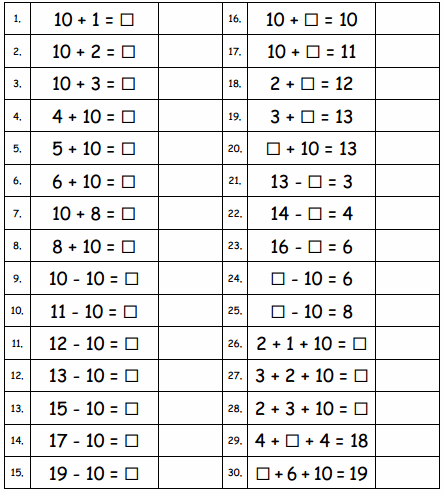
Answer:
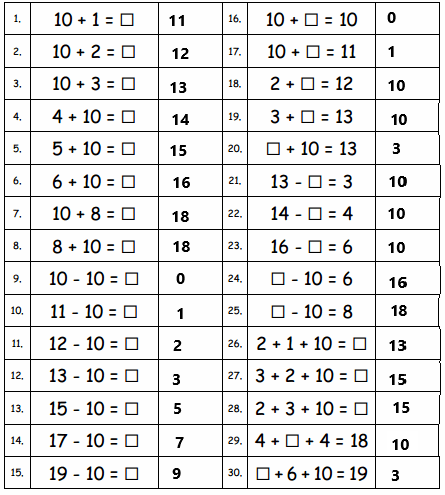
Question 1.
10 + 1 = ☐
Answer:
10 + 1 = 11
Explanation:
An addition sentence is a mathematical expression that shows two or more values added together. ADD ten with one then we got eleven. The missing number is eleven.
Question 2.
10 + 2 = ☐
Answer:
10 + 2 = 12
Explanation:
An addition sentence is a mathematical expression that shows two or more values added together. ADD ten with two then we got twelve. The missing number is twelve.
Question 3.
10 + 3 = ☐
Answer:
10 + 3 = 13
Explanation:
An addition sentence is a mathematical expression that shows two or more values added together. ADD ten with three then we got thirteen. The missing number is thirteen.
Question 4.
4 + 10 = ☐
Answer:
4 + 10 = 14
Explanation:
An addition sentence is a mathematical expression that shows two or more values added together. ADD four with ten then we got fourteen. The missing number is fourteen.
Question 5.
5 + 10 = ☐
Answer:
5 + 10 = 15
Explanation:
An addition sentence is a mathematical expression that shows two or more values added together. ADD five with ten then we got fifteen. The missing number is fifteen.
Question 6.
6 + 10 = ☐
Answer:
6 + 10 = 16
Explanation:
An addition sentence is a mathematical expression that shows two or more values added together. ADD six with ten then we got sixteen. The missing number is sixteen.
Question 7.
10 + 8 = ☐
Answer:
10 + 8 = 18
Explanation:
An addition sentence is a mathematical expression that shows two or more values added together. ADD ten with eight then we got eighteen. The missing number is eighteen.
Question 8.
8 + 10 = ☐
Answer:
8 + 10 = 18
Explanation:
An addition sentence is a mathematical expression that shows two or more values added together. ADD eight with ten then we got eighteen. The missing number is eighteen.
Question 9.
10 – 10 = ☐
Answer:
10 – 10 = 0
Explanation:
Subtraction is an arithmetic operation that represents the operation of removing objects from a collection. The result of a subtraction is called a difference. Subtract ten from ten then we got zero. The missing number is zero.
Question 10.
11 – 10 = ☐
Answer:
11 – 10 = 1
Explanation:
Subtraction is an arithmetic operation that represents the operation of removing objects from a collection. The result of a subtraction is called a difference. Subtract ten from eleven then we got one. The missing number is one.
Question 11.
12 – 10 = ☐
Answer:
12 – 10 = 2
Explanation:
Subtraction is an arithmetic operation that represents the operation of removing objects from a collection. The result of a subtraction is called a difference. Subtract ten from twelve then we got two. The missing number is two.
Question 12.
13 – 10 = ☐
Answer:
13 – 10 = 3
Explanation:
Subtraction is an arithmetic operation that represents the operation of removing objects from a collection. The result of a subtraction is called a difference. Subtract ten from thirteen then we got three. The missing number is three.
Question 13.
15 – 10 = ☐
Answer:
15 – 10 = 5
Explanation:
Subtraction is an arithmetic operation that represents the operation of removing objects from a collection. The result of a subtraction is called a difference. Subtract ten from fifteen then we got five. The missing number is five.
Question 14.
17 – 10 = ☐
Answer:
17 – 10 = 7
Explanation:
Subtraction is an arithmetic operation that represents the operation of removing objects from a collection. The result of a subtraction is called a difference. Subtract ten from seventeen then we got seven. The missing number is seven.
Question 15.
19 – 10 = ☐
Answer:
19 – 10 = 9
Explanation:
Subtraction is an arithmetic operation that represents the operation of removing objects from a collection. The result of a subtraction is called a difference. Subtract ten from nineteen then we got nine. The missing number is nine.
Question 16.
10 + ☐ = 10
Answer:
10 + 0 = 10
Explanation:
An addition sentence is a mathematical expression that shows two or more values added together. ADD ten with zero then we got ten. The missing number is zero.
Question 17.
10 + ☐ = 11
Answer:
10 + 1 = 11
Explanation:
An addition sentence is a mathematical expression that shows two or more values added together. ADD ten with one then we got eleven. The missing number is one.
Question 18.
2 + ☐ = 12
Answer:
2 + 10 = 12
Explanation:
An addition sentence is a mathematical expression that shows two or more values added together. ADD two with ten then we got twelve. The missing number is ten.
Question 19.
3 + ☐ = 13
Answer:
3 + 10 = 13
Explanation:
An addition sentence is a mathematical expression that shows two or more values added together. ADD three with ten then we got thirteen. The missing number is ten.
Question 20.
☐ + 10 = 13
Answer:
3 + 10 = 13
Explanation:
An addition sentence is a mathematical expression that shows two or more values added together. ADD three with ten then we got thirteen. The missing number is three.
Question 21.
13 – ☐ = 3
Answer:
13 – 10 = 3
Explanation:
Subtraction is an arithmetic operation that represents the operation of removing objects from a collection. The result of a subtraction is called a difference. Subtract ten from thirteen then we got three. The missing number is ten.
Question 22.
14 – ☐ = 4
Answer:
14 – 10 = 4
Explanation:
Subtraction is an arithmetic operation that represents the operation of removing objects from a collection. The result of a subtraction is called a difference. Subtract ten from fourteen then we got four. The missing number is ten.
Question 23.
16 – ☐ = 6
Answer:
16 – 10 = 6
Explanation:
Subtraction is an arithmetic operation that represents the operation of removing objects from a collection. The result of a subtraction is called a difference. Subtract ten from sixteen then we got six. The missing number is ten.
Question 24.
☐ – 10 = 6
Answer:
16 – 10 = 6
Explanation:
Subtraction is an arithmetic operation that represents the operation of removing objects from a collection. The result of a subtraction is called a difference. Subtract ten from sixteen then we got six. The missing number is sixteen.
Question 25.
☐ – 10 = 8
Answer:
18 – 10 = 8
Explanation:
Subtraction is an arithmetic operation that represents the operation of removing objects from a collection. The result of a subtraction is called a difference. Subtract ten from eighteen then we got eight. The missing number is eighteen.
Question 26.
2 + 1 + 10 = ☐
Answer:
2 + 1 + 10 = 13
Explanation:
An addition sentence is a mathematical expression that shows two or more values added together. ADD two with one and ten then we got thirteen. The missing number is thirteen.
Question 27.
3 + 2 + 10 = ☐
Answer:
3 + 2 + 10 = 15
Explanation:
An addition sentence is a mathematical expression that shows two or more values added together. ADD three with two and ten then we got fifteen. The missing number is fifteen.
Question 28.
2 + 3 + 10 = ☐
Answer:
2 + 3 + 10 = 15
Explanation:
An addition sentence is a mathematical expression that shows two or more values added together. ADD two with three and ten then we got fifteen. The missing number is fifteen.
Question 29.
4 + ☐ + 4 = 18
Answer:
4 + 10 + 4 = 18
Explanation:
An addition sentence is a mathematical expression that shows two or more values added together. ADD four with ten and four then we got eighteen. The missing number is ten.
Question 30.
☐ + 6 + 10 = 19
Answer:
3 + 6 + 10 = 19
Explanation:
An addition sentence is a mathematical expression that shows two or more values added together. ADD three with six and ten then we got nineteen. The missing number is three.
Eureka Math Grade 1 Module 2 Lesson 27 Problem Set Answer Key
Solve the problems. Write your answers to show how many tens and ones. If there is only 1 ten, cross off the “s.”
Add.
Question 1.

__ tens and __ ones
Answer:
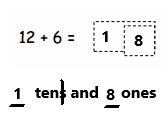
Explanation:
In the above image we can observe a expression 12 + 6. An addition sentence is a mathematical expression that shows two or more values added together and their sum. By adding above two numbers twelve and six we got eighteen. Now we have one ten and eight ones. Since it is just 1 ten, we can cross of the “s.”
Question 2.

__ tens and __ ones
Answer:
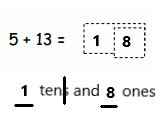
Explanation:
In the above image we can observe a expression 5 + 13. An addition sentence is a mathematical expression that shows two or more values added together and their sum. By adding above two numbers five and thirteen we got eighteen. Now we have one ten and eight ones. Since it is just 1 ten, we can cross of the “s.”
Question 3.

__ tens and __ ones
Explanation:
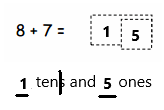
Explanation:
In the above image we can observe a expression 8+ 7. An addition sentence is a mathematical expression that shows two or more values added together and their sum. By adding above two numbers eight and seven we got fifteen. Now we have one ten and five ones. Since it is just 1 ten, we can cross of the “s.”
Question 4.

__ tens and __ ones
Answer:
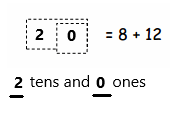
Explanation:
In the above image we can observe a expression 8 + 12. An addition sentence is a mathematical expression that shows two or more values added together and their sum. By adding above two numbers eight and twelve we got twenty. Now we have two tens and zero ones.
Subtract.
Question 5.

__ tens and __ ones
Answer:
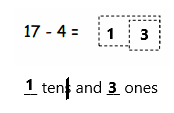
Explanation:
In the above image we can observe a expression 17 – 4. Subtraction is an arithmetic operation that represents the operation of removing objects from a collection. The result of a subtraction is called a difference. Subtract four from seventeen then we got thirteen. Now we have one ten and three ones. Since it is just 1 ten, we can cross of the “s.”
Question 6.

__ tens and __ ones
Answer:

Explanation:
In the above image we can observe a expression 17 – 5. Subtraction is an arithmetic operation that represents the operation of removing objects from a collection. The result of a subtraction is called a difference. Subtract five from seventeen then we got twelve. Now we have one ten and two ones. Since it is just 1 ten, we can cross of the “s.”
Question 7.

__ tens and __ ones
Answer:

Explanation:
In the above image we can observe a expression 14 – 6. Subtraction is an arithmetic operation that represents the operation of removing objects from a collection. The result of a subtraction is called a difference. Subtract six from fourteen then we got eight. Now we have zero tens and eight ones.
Question 8.

__ tens and __ ones
Answer:

Explanation:
In the above image we can observe a expression 16 – 7. Subtraction is an arithmetic operation that represents the operation of removing objects from a collection. The result of a subtraction is called a difference. Subtract seven from sixteen then we got nine. Now we have zero tens and nine ones.
Read the word problem. Draw and label. Write a number sentence and statement that matches the story. Rewrite your answer to show its tens and ones. If there is only 1 ten, cross off the “s.”
Question 9.
Frankie and Maya made 4 big sandcastles at the beach. If they made 10 small sandcastles, how many total sandcastles did they make?
__ tens and __ ones
Answer:
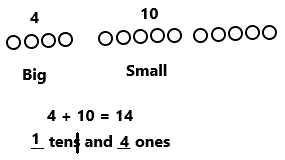
They made 14 sandcastles.
Explanation:
Frankie and Maya made 4 big sandcastles at the beach. If they made 10 small sandcastles as we can observe in the above image. An addition sentence is a mathematical expression that shows two or more values added together and their sum. Draw four big sandcastles and ten small sandcastles and label them as big and small. ADD four big and ten small then we got fourteen sandcastles. Now we have one ten and four ones. Since it is just 1 ten, we can cross of the “s.” They made fourteen sandcastles.
Question 10.
Ronnie has 8 stickers that are stars. Her friend Sina gives her 7 more. How many stickers does Ronnie have now?
__ tens and __ ones
Answer:
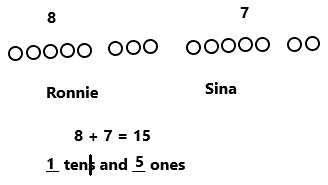
Ronnie has 15 stickers.
Explanation:
Ronnie has 8 stickers that are stars. Her friend Sina gives her 7 more as we can observe in the above image. An addition sentence is a mathematical expression that shows two or more values added together and their sum. Draw eight stickers and seven stickers. By adding Ronnie stickers and her friend stickers results total number of stickers. ADD eight stickers and seven stickers then we got fifteen stickers. Now we have one ten and five ones. Since it is just 1 ten, we can cross of the “s.” Ronnie has fifteen stickers.
Question 11.
We tied 14 balloons to the tables for a party, but 3 floated away! How many balloons were still tied to the tables?
__ tens and __ ones
Answer:
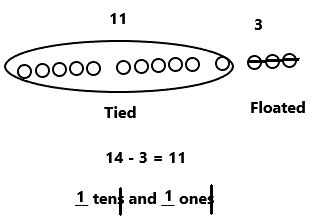
11 balloons were tied.
Explanation:
We tied 14 balloons to the tables for a party, but 3 floated away as we can observe in the above image. Subtraction is an arithmetic operation that represents the operation of removing objects from a collection. The result of a subtraction is called a difference. Draw fourteen balloons and cross out three balloons which are floated away. Subtract three from fourteen then we got eleven balloons. Draw a circle for eleven balloons. Now we have one ten and eight ones. Since it is just 1 ten, so we can cross of the “s.” Eleven balloons were tied.
Question 12.
I ate 5 of the 16 strawberries that I picked. How many did I have left over?
__ tens and __ ones
Answer:

I had 11 strawberries left.
Explanation:
I ate 5 of the 16 strawberries that I picked as we can observe in the above image. Draw a neat 5-group rows. Draw sixteen circles and cross out five circles because those circles are ate. Label those five circles as ate. Subtract five from sixteen then we got eleven strawberries. Label eleven strawberries as left. Now we have one ten and one ones. Since it is just 1 ten, and 1 one so we can cross of the “s.” I had eleven strawberries left.
Eureka Math Grade 1 Module 2 Lesson 27 Exit Ticket Answer Key
Solve the problems. Write the answers to show how many tens and ones. If there is only one ten, cross off the “s.”
Question 1.
![]()
__ tens and __ ones
Answer:

Explanation:
In the above image we can observe a expression 13 + 6. An addition sentence is a mathematical expression that shows two or more values added together and their sum. By adding above two numbers thirteen and six we got nineteen. Now we have one ten and nine ones. Since it is just 1 ten, we can cross of the “s.”
Question 2.
![]()
__ tens and __ ones
Answer:

Explanation:
In the above image we can observe a expression 7 + 6. An addition sentence is a mathematical expression that shows two or more values added together and their sum. By adding above two numbers seven and six we got thirteen. Now we have one ten and three ones. Since it is just 1 ten, we can cross of the “s.”
Read the word problem. Draw and label. Write a number sentence and statement that matches the story. Rewrite your answer to show its tens and ones.
Question 3.
Kendrick went bowling. He knocked down 16 pins in the first two frames. If he knocked down 9 in the first frame, how many pins did he knock down in the second frame?
__ tens and __ ones
Answer:
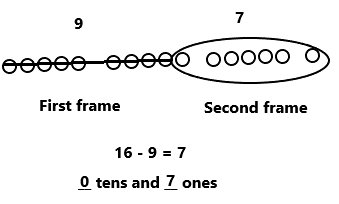
Kendrick knocked down 7 pins in the second frame.
Explanation:
Kendrick went bowling. He knocked down 16 pins in the first two frames. He knocked down 9 in the first frame. In the above image we can observe 16pins. Draw sixteen circles and label nine circles as first frame. Cross out nine circles. Subtract nine from sixteen then we got seven. Label seven circles as second frame. Now we have zero tens and seven ones. Kendrick knocked down seven pins in the second frame.
Eureka Math Grade 1 Module 2 Lesson 27 Homework Answer Key
Solve the problems. Write the answers to show how many tens and ones. If there is only one ten, cross off the “s.”
Question 1.

__ tens and __ ones
Answer:
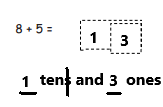
Explanation:
In the above image we can observe a expression8 + 5. An addition sentence is a mathematical expression that shows two or more values added together and their sum. By adding above two numbers eight and five we got thirteen. Now we have one ten and three ones. Since it is just 1 ten, we can cross of the “s.”
Question 2.

__ tens and __ ones
Answer:
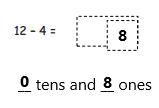
Explanation:
In the above image we can observe a expression 12 – 4. Subtraction is an arithmetic operation that represents the operation of removing objects from a collection. The result of a subtraction is called a difference. Subtract four from twelve then we got eight. Now we have zero tens and eight ones.
Question 3.

__ tens and __ ones
Answer:
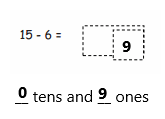
Explanation:
In the above image we can observe a expression 15 – 6. Subtraction is an arithmetic operation that represents the operation of removing objects from a collection. The result of a subtraction is called a difference. Subtract six from fifteen then we got nine. Now we have zero tens and nine ones.
Question 4.

__ tens and __ ones
Answer:

Explanation:
In the above image we can observe a expression 14 + 5. An addition sentence is a mathematical expression that shows two or more values added together and their sum. By adding above two numbers fourteen and five we got nineteen. Now we have one ten and nine ones. Since it is just 1 ten, we can cross of the “s.”
Question 5.

__ tens and __ ones
Answer:
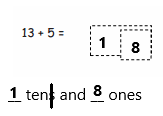
Explanation:
In the above image we can observe a expression 13 + 5. An addition sentence is a mathematical expression that shows two or more values added together and their sum. By adding above two numbers thirteen and five we got eighteen. Now we have one ten and eight ones. Since it is just 1 ten, we can cross of the “s.”
Question 6.

__ tens and __ ones
Answer:

Explanation:
In the above image we can observe a expression 17 – 8. Subtraction is an arithmetic operation that represents the operation of removing objects from a collection. The result of a subtraction is called a difference. Subtract eight from seventeen then we got nine. Now we have zero tens and nine ones.
Read the word problem. Draw and label. Write a number sentence and statement that matches the story. Rewrite your answer to show its tens and ones. If there is only 1 ten, cross off the “s.”
Question 7.
Mike has some red cars and 8 blue cars. If Mike has 9 red cars, how many cars does he have in all?
__ tens and __ ones
Answer:

Mike have 17 cars altogether.
Explanation:
Mike has 9 red cars and 8 blue cars. Draw nine circles and label them as red. Draw eight circles and label them as blue and draw a circle for nine red cars. ADD nine red cars and eight blue cars then we got seventeen cars. Now we have one ten and seven ones. Since it is just 1 ten, we can cross of the “s.” Mike have seventeen cars altogether.
Question 8.
Yani and Han had 14 golf balls. They lost some balls. They had 8 golf balls left. How many balls did they lose?
__ tens and __ ones
Answer:

They lose 6 balls.
Explanation:
Yani and Han had 14 golf balls. They lost some balls. They had 8 golf balls left. Draw fourteen circles. Label eight circles as left and remaining circles as lost. Subtract eight from fourteen then we got six. Six circles represents lost balls. They lose six balls. Now we have zero tens and six ones.
Question 9.
Nick rides his bike for 6 miles over the weekend. He rides 14 miles during the week. How many total miles does Nick ride?
__ tens and __ ones
Answer:
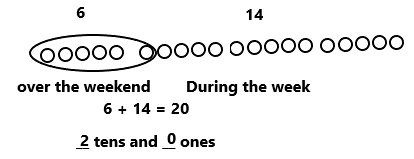
Nick ride his bike for 20 miles.
Explanation:
Nick rides his bike for 6 miles over the weekend. He rides 14 miles during the week. Draw a six circles and fourteen circles. Label them as over the weekend and during the weekend. Draw a circle for six miles. ADD six with fourteen then we got twenty. Nick ride his bike for twenty miles. Now we have two tens and zero ones.